Delaware VI (Battleship No. 28)
1910-1923
The first state in the Union; ratified the United States Constitution on 7 December 1787.
VI
(Battleship No. 28: displacement 20,380; length 518'9"; breadth 86'3"; draft 27'4"; speed 21 knots.; complement 933; armament 10 12-inch/45 caliber, 14 5-inch, 2 3-inch anti-aircraft guns, 2 21-inch torpedo tubes; class Delaware)
The sixth Delaware (Battleship No. 28) was laid down on 11 November 1907 at Newport News, Va., by the Newport News Shipbuilding Co.; launched on 6 February 1909; sponsored by Miss Anna P. Cahall, niece of Simeon S. Pennewill, Governor of Delaware; and commissioned on 4 April 1910 at Norfolk, Va.; Capt. Charles A. Gove in command.
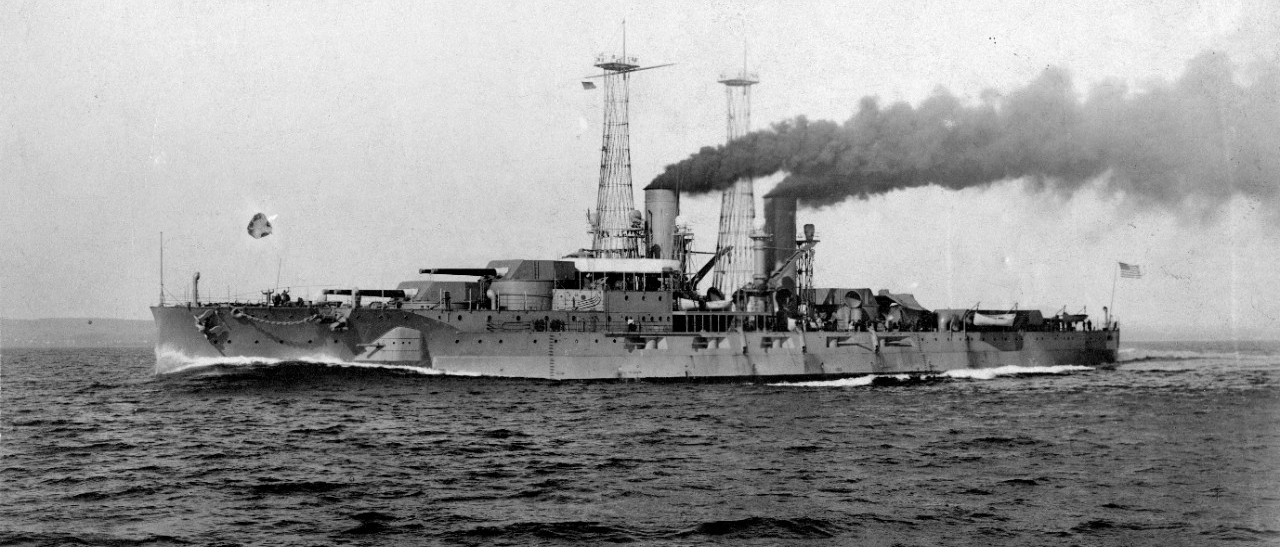
After visiting Wilmington, Del., from 3 to 9 October 1910, to receive a gift of a silver service from the state, Delaware sailed from Hampton Roads, Va. on 1 November, with the First Battleship Division, Atlantic Fleet, to visit Weymouth, England, and Cherbourg, France, and after battle practice at Guantanamo Bay, Cuba, she steamed to Norfolk. While en route, there was an explosion on board the ship that killed nine men, the ship arrived at Norfolk on 18 January 1911. She departed on 31 January to carry the remains of Chilean Minister Anibal Cruz to Valparaiso, sailing by way of Rio de Janeiro, Brazil, and Punta Arenas, Chile. Returning to New York on 5 May, she sailed on 4 June for Portsmouth, England, where from 19-28 June, she took part in the fleet review accompanying the coronation of King George V. Afterward, she returned to the United States and stood in to the Boston [Mass.] Navy Yard to refuel on 9 July. Getting underway on 16 July, Delaware conducted tactical exercises and drills off the New England coast into August.
Delaware weighed anchor at Provincetown, Mass., on 21 August and steamed south. After taking on stores and ammunition at New York (22-24 August), she arrived at Hampton Roads on the 25th. For the next several weeks, she conducted exercises and training in the Chesapeake Bay and on the Southern Drill Grounds. Part of these exercises included experimental gunnery practices at Hampton Roads (12-17 September). Entering drydock at the Norfolk Navy Yard on 17 September and undocked the next day. Getting underway that same day, she steamed to Tompkinsville [Staten Island], N.Y. Two days later, on the 21st, she shifted to the New York Navy Yard and underwent overhaul until 28 October. With her yard work suspended, she moved to the North River and participated in a naval review (28 October-2 November). She returned to the New York Navy Yard, via Tompkinsville, on 4 November and continued her overhaul through the end of the year.
Delaware finally completed her overhaul and departed the New York Navy Yard on 4 January 1912. Bound for the Fleet’s annual winter tactical exercises, she arrived at Guantanamo Bay, Cuba, on 14 January, having conducted trials en route. She conducted exercises in the Caribbean until raising Lynnhaven Roads, Va., on 21 March. Having arrived in the Hampton roads area, Delaware spent the next several weeks conducting additional gunnery and spotting exercises. Departing Hampton Roads on 13 April, after taking on coal and stores, the battleship arrived at the New York Navy Yard for repairs (16-30 April). After a brief visit to Tompkinsville on 30 April, Delaware set a course for Newport, R.I., on 1 May, arriving on the 8th. After assisting Montana (Armored Cruiser No. 13) with experimental firing in Long Island Sound (8-9 May), Delaware returned to Newport and overhauled her machinery until 21 May. She then conducted torpedo practice off Newport (21-25 May) and after embarking marines from Wakefield [R.I.] rifle range, she steamed to New York to participate in Decoration Day exercises off Grant’s Tomb on the 30th. The next day, 1 June, she moved to Tompkinsville to take on provisions and then steamed to Hampton Roads. Arriving on 2 June, Delaware met a squadron from the Imperial German Navy (2-5 June). She then moved up the Chesapeake Bay to U.S. Naval Academy at Annapolis, Md., to receive midshipmen (5-10 June). Returning to Hampton Roads to coal, the battleship departed for Boston on 13 June and arrived on the 15th. In company with Florida (Battleship No. 30) and Utah (Battleship No. 31), she landed a battalion for the Bunker Hill Day celebration and conducted drills (15-18 June). Later on the 18th, she shifted to Provincetown, Mass., and remained there through the end of June.
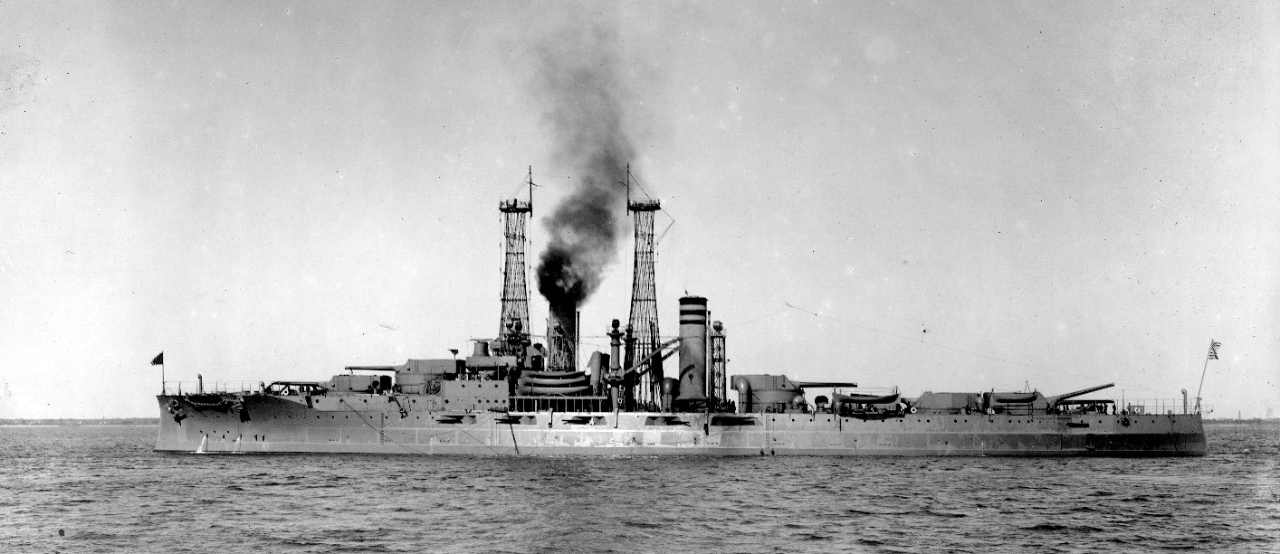
From 1 July 1912, Delaware operated along the New England coast until 17 August when she stood out of Newport, bound for Hampton Roads. Arriving on 21 August, the battleship operated in the Chesapeake Bay and on the Southern Drill Grounds until she returned to Newport on 14 September. Except for getting underway for exercises on 26 September, she remained at Newport until 5 October when she departed for the Maine Memorial Exercises in New York City. On 14 October 1912 she passed before President William Howard Taft and Secretary of the Navy George von Lengerke Meyer, on board the presidential yacht, Mayflower, in the Naval Review in the North River.
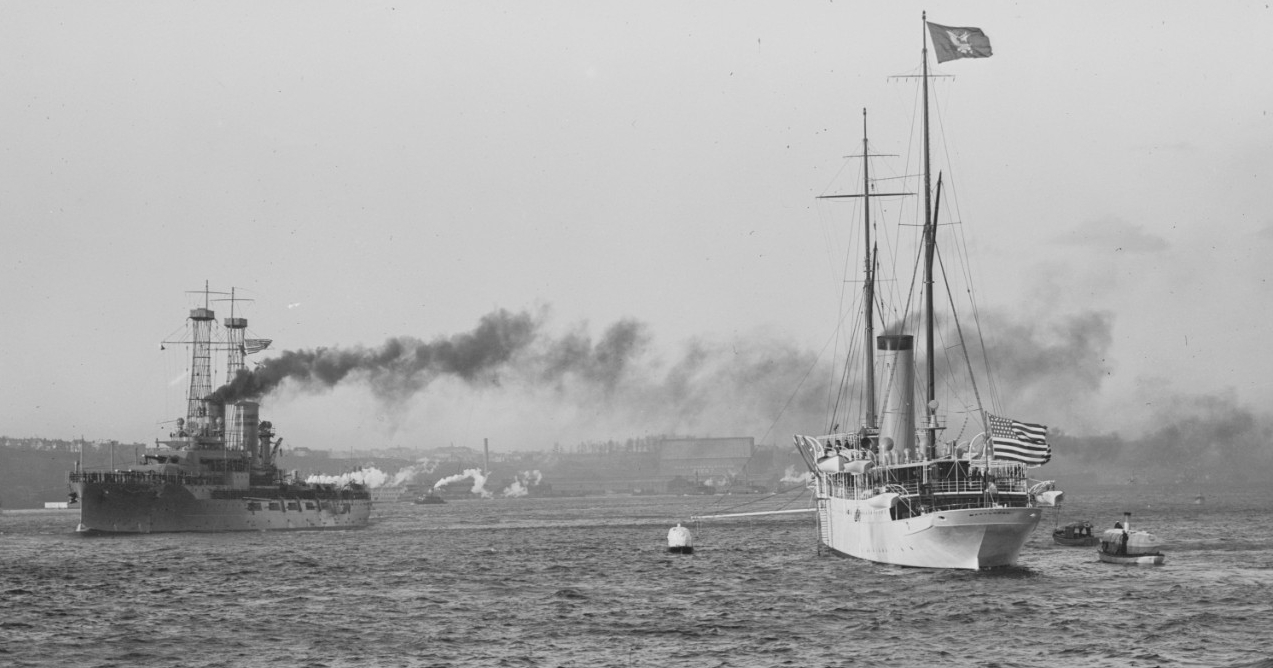
Delaware shifted to the New York Navy Yard on 15 October 1912. Docking the next day, she underwent repairs until undocking on the 19th. After a period at Tompkinsville, until 29 October, she shifted to Rockland, Maine, (31 October-3 November) before returning south to Hampton Roads and the Southern Drill Grounds after 5 November. After the exercises, the fleet moved to Charleston, S.C. for a week-long port visit and liberty (17-24 November). After a brief visit to Hampton Roads, Delaware conducted divisional maneuvers on the Southern Drill Grounds (2-10 December) and then convoyed Arkansas (Battleship No. 33) with President William H. Taft embarked to conduct a visit to Colon, Panama and the under-construction Panama Canal (24-26 December). After touching at Key West, Fla., on the 29th, Delaware arrived at Tompkinsville on 1 January 1913.
Delaware entered the New York Navy Yard on 4 January 1913 and underwent overhaul until 31 March. Getting underway on 1 April, the battleship headed south and conducted trials on the Southern Drill Grounds before anchoring in Tangier Sound in the Chesapeake on 6 April. While there, she adjusted her rangefinders until the 8th and the getting underway conducted maneuvers on the drill grounds until 16 April. After re-provisioning at Hampton Roads, she conducted torpedo practices in the Chesapeake (19-22 April). After towing targets at Lynnhaven Roads (29 April-2 May), she moved north. Taking on stores at Tompkinsville, she conducted tactical maneuvers with the Fleet through much of May before shifting to New York to participate in the Maine memorial services. Afterward, she steamed southward. Re-fueling at Hampton Roads (1-4 June), she steamed up the Chesapeake and embarked midshipmen at the Naval Academy (5-9 June). Passing back through the Virginia capes, Delaware returned north and participated in tactical exercises of Block Island [R.I], 11-12 June. She returned to the New York Navy yard via Tompkinsville and entered the yard for repairs on 13 June. She remained there through 9 July.
Getting underway with the completion of the repairs, Delaware conducted training maneuvers off the New England and New York coasts to 22 August. Departing Napeague, N.Y. that day, the battleship charted a course for Annapolis, Md., and disembarked the midshipmen there on 24-25 August. With the midshipmen training cruise completed, she turned to additional gunnery exercises and tactical training in the Chesapeake Bay and on the Southern Drill Grounds. After taking on stores at Hampton Roads, 14-15 September, Delaware returned to the New York Navy Yard via Tompkinsville. Entering the yard on 17 September, the battleship underwent repairs until 1 October. After the completion of her year period, she returned to the Hampton roads area and underwent trials and calibration of her equipment, as well as tactical training until 18 October. She then took on coal and stores (18-25 October) for a European cruise. Crossing the Atlantic in company with Wyoming (Battleship No. 32) and Utah, Delaware visited Villefranche, France, (8-30 November). Returning to Hampton Roads on 19 December, Delaware entered the Norfolk Navy Yard for maintenance through 7 January 1914.
Upon leaving the yard, Delaware set a course for the Caribbean and the Fleet’s annual winter exercises. Arriving at Culebra on 16 January 1914, the battleship operated with the fleet conducting exercises at Guantanamo Bay, Guacanayabo Bay, and off Vera Cruz, Mexico through 5 March. Returning to Hampton Roads on 12 March, Delaware continued to operate in the vicinity of Hampton Roads conducting gunnery training and calibration of equipment. She entered the Norfolk Navy Yard on 10 April for an overhaul period.
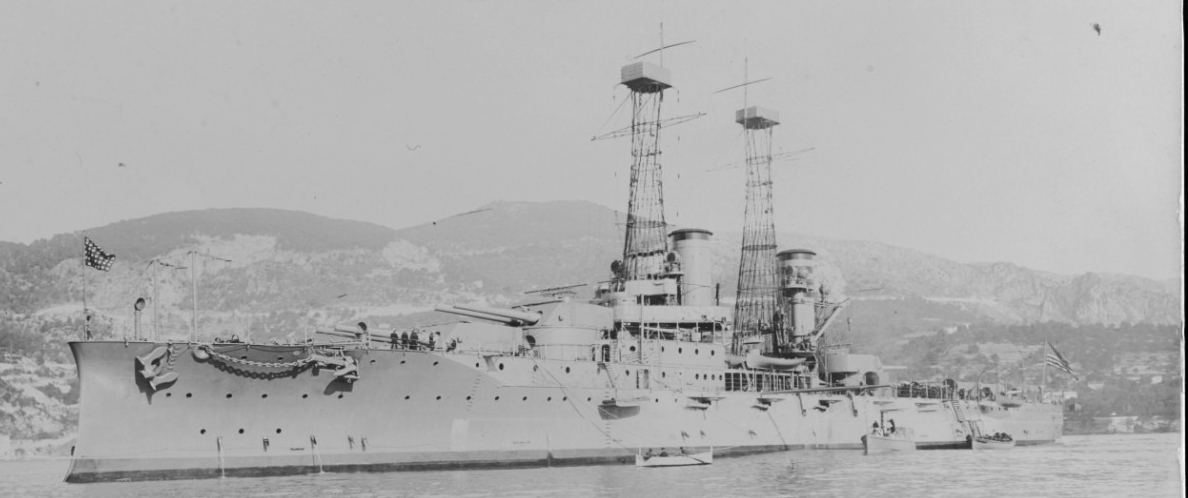
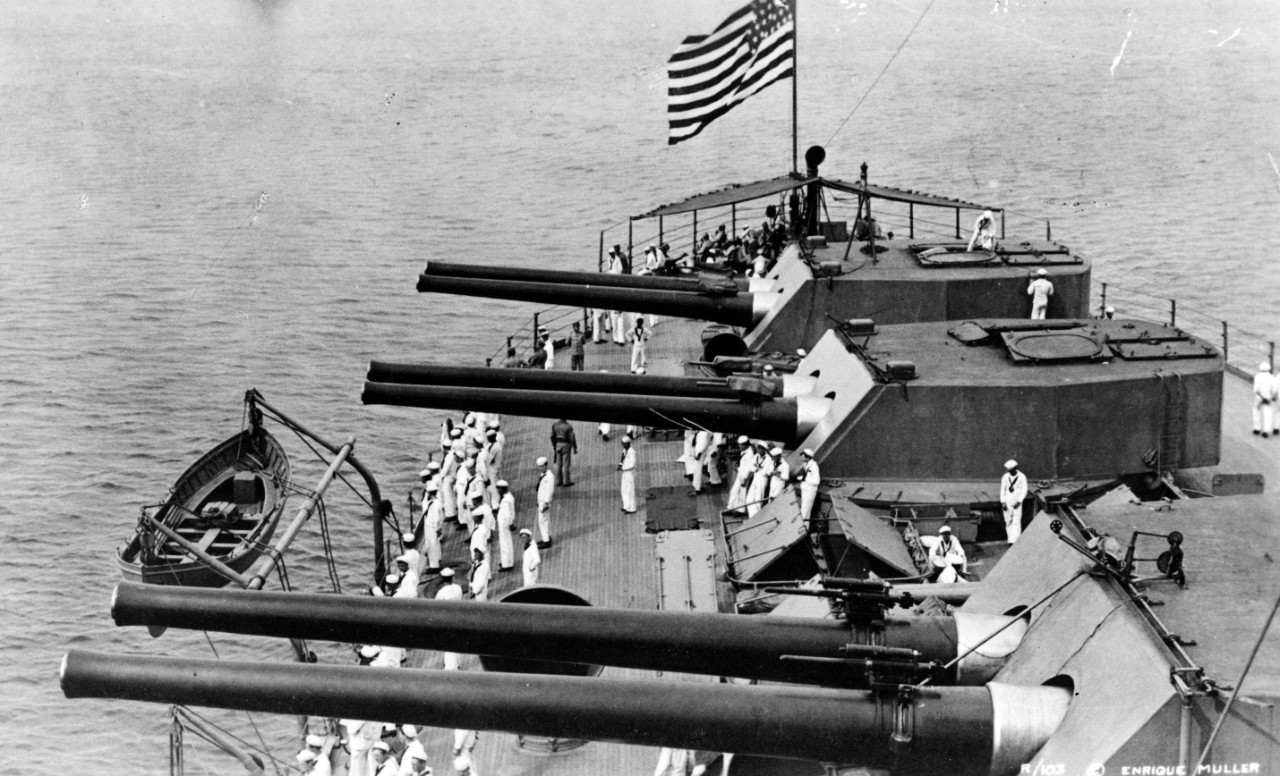
In early 1914, Mexico suffered the throes of revolution (1910-1920). President Victoriano Huerta faced challenges from Emiliano Zapata and his rebels in southern Mexico and the Constitutionalists under Venustiano Carranza in the north. With that ongoing internecine conflict and heightening tension between the U.S. and Mexico, President Woodrow Wilson had concerns for the safety of American citizens and business interests. On 9 April 1914, the commanding officer of the gunboat Dolphin at the Mexican port of Tampico dispatched a purser and eight sailors ashore to purchase fuel for the ship. Though the sailors were on board a whaleboat flying the U.S. colors, forces loyal to Huerta seized the men and escorted them to the nearby regimental headquarters. Rear Adm. Henry T. Mayo, the commander of the Fourth Battleship Division, Atlantic Fleet, demanded a 21-gun salute and a formal apology from Huerta's government. While Huerta ordered the release of the sailors within 24 hours and gave a written apology, he refused to have his forces raise the U.S. flag and provide a 21-gun salute. As a result of the “Tampico Affair,” President Wilson asked Congress for permission for a landing at Vera Cruz to seize the Customs House there and prevent a shipment of arms from Germany being landed for Huerta’s forces.
At the direction of Rear Adm. Frank F. Fletcher, on the morning of 21 April 1914, a combined force of bluejackets and marines went ashore. Joined by marines from the Second Advanced Base regiment embarked on the transport Prairie, these units seized the Customs House at Vera Cruz. They were reinforced by landing forces from other ships of the fleet the next day, 22 April. They secured the town and held it for a week until relieved by U.S. Army forces commanded by Brig. Gen. Frederick N. Funston. The fleet continued to support the occupation of the port while also making occasional runs to sea for divisional and fleet exercises.
Delaware stood out of Norfolk bound for Vera Cruz on 1 July 1914. Arriving a week later, on 8 July, the battleship cruised off the Mexican city and supported the U.S. occupation forces there.
Delaware received orders transferring her from the First Battleship Division to the Second Battleship Division, Atlantic Fleet on 8 September. She remained in the vicinity until 2 October, when she departed for Tuxpan, Mexico. After a week, she set a course for Key West, Fla., arriving on 13 October. While en route, she was again transferred, this time back into the First Battleship Division, Atlantic Fleet. After a short run to Guantanamo Bay, Cuba, Delaware stood in to Hampton Roads on 22 October. She continued to operate in the vicinity of Hampton Roads through most of the remainder on 1914. Just before New Year’s Day, she got underway from Norfolk on 29 December, bound for a return to Mexican waters.
Delaware returned to Vera Cruz on 13 January 1915 and continued to operate in the area into April. Departing Vera Cruz on the 3rd, she returned to Hampton Roads two days later. After almost four and a half years of operational service, Delaware was in need of a lengthy maintenance period after her return to the U.S. Entering the Norfolk Navy Yard on 7 June, she underwent an extensive overhaul through most of the remainder of 1915. Getting underway on 9 December, she underwent trials and training on the Southern Drill Grounds until returning to Norfolk on the 16th, where she remained through year’s end.
Delaware got underway from Norfolk on 6 January 1916 and headed south to participate in the Fleet’s annual winter maneuvers in the Caribbean. Having conducted gunnery training and battle practices at various locations, Culebra, P.R.; Guantanamo Bay, and Guacanayabo Bay, Cuba, Delaware returned to Hampton Roads on 14 April. Entering the Norfolk Navy Yard that same day, she remained there until 15 May. Upon the completion of that work, she was transferred from the First Battleship Division to the Sixth Battleship Division, Atlantic Fleet. After training on the Southern Drill Grounds (20-22 May), the battleship steamed north and raised Newport, R.I. on the 23rd. She then spent the summer cruising and conducting exercises and port visits along the New England coast. On 30 August, she departed Newport and returned two days later, 1 September, to Hampton Roads. For the remainder of 1916, she would operate in the vicinity of the Virginia capes.
Still at Norfolk on 1 January 1917, Delaware got underway via Lynnhaven Roads, Va. on 16 January, for the Fleet’s annual winter training in the Caribbean. As a result of Germany’s resumption of unrestricted submarine warfare on 1 February 1917, the United States severed diplomatic relations on 3 February 1917. This prompted the Navy to change the base of the Atlantic Fleet under the command of Adm. Henry T. Mayo from Guantanamo Bay to Guacanayabo Bay. The Fleet’s Battleship Force was under the command of Vice Adm. DeWitt Coffman. Delaware, along with New York (Battleship No. 34), Texas (Battleship No. 35), and Oklahoma (Battleship No. 37), was a constituent of the Sixth Battleship Division under Rear Adm. Augustus F. Fechteler. While at Guacanayabo Bay, the Fleet completed the annual target practices and gunnery exercises as scheduled.
On 20 March 1917, the Fleet left Guacanayabo and returned to Guantanamo the next day and then departed for Hampton Roads, Va., on 23 March. They arrived on the 27th. Shifting from Hampton Roads, the Navy established a fleet base in the York River off Yorktown, Va., on 2 April. After the 6 April declaration of war against Germany, a submarine defense net was placed across the York River and Delaware mobilized for war. Receiving recruits of various kinds, she began intensive training and gunnery practice, especially on submarines as targets. Delaware held rehearsals and conducted battle practice in the Chesapeake Bay and at sea with other vessels of the Atlantic Fleet. She remain stationed at the York River base until 30 July when she got underway for the Boston Navy Yard accompanied by Wyoming and escorted by the destroyers, Monaghan (Destroyer No. 32) and Henley (Destroyer No. 39). While Wyoming went to the New York Navy Yard, arriving on 31 July, Delaware continued on to the Boston Navy Yard, where she arrived on 1 August.
On 4 August 1917, the ship’s battalion participated in a parade in Boston in honor of the Belgian Commission. Later that month, on 27 August, Delaware escorted by Henley and Preble, left the Boston Navy Yard for Port Jefferson [Long Island], N.Y., where the Fleet was then located. Delaware arrived on 28 August. During September, the entire Fleet, including destroyers, went to sea for a week’s maneuvers, returning to the base at Port Jefferson on 1 October. The fleet then again left Port Jefferson for maneuvers at sea en route to Yorktown, where it arrived on 6 October. The remainder of the month and into early November, Delaware prepared for the Autumn Target Practice.
The Navy Department, on 12 November 1917, selected the coal-burners -- New York, Florida, Wyoming, and Delaware -- to form Battleship Division Nine as reinforcement for the British Grand Fleet. The battleships were to be commanded by Rear Adm. Hugh Rodman. Delaware received instructions to sail for the Boston Navy Yard to be outfitted for distant service. She got underway for Boston the next day, the same day Rodman assumed his command, and arrived on 15 November. Delaware left the Boston Navy Yard on 24 November and arrived that same day at Lynnhaven Roads, Va., where she anchored with the other units of the division.
At 3:00 p.m. on 25 November 1917, Battleship Division Nine sailed from Lynnhaven Roads with Manley (Destroyer No. 74) in escort. While Manley was to join the convoy escort and patrol forces based at Base No. 6, Queenstown [Cobh], Ireland, Battleship Division Nine was bound for the Royal Navy Grand Fleet’s anchorage at Scapa Flow, Orkney Islands, Scotland, to serve under the command of Adm. Sir David Beatty, RN. Embarked on Delaware were Cmdr. Richard H. Leigh and a party of four technical experts, two officers and six enlisted men who were trained listeners in the C tube underwater listening apparatus. With the men are six sets of C tubes, six set of C tubes for installation through the bottoms of vessels, four sets of K tubes, four sets of radio telephones, and one Mason detection device for testing and demonstration in European waters.
The weather on the voyage was bad from the start, but worsened during the night of 30 November-1 December. Delaware and Florida lost contact with New York and Wyoming. Eventually Delaware steamed singly and passed through the appointed rendezvous without sighting any of her cohorts. At 2:15 p.m. on 6 December, Delaware sighted the British C-class light cruiser, HMS Constance. Together the two ships joined the rest of Battleship Division Nine at 7:00 a.m. on 7 December at Cape Wrath and continued on to Scapa Flow. With a hearty welcome from the crews of the ships of the Grand Fleet, the ships anchored at noon.
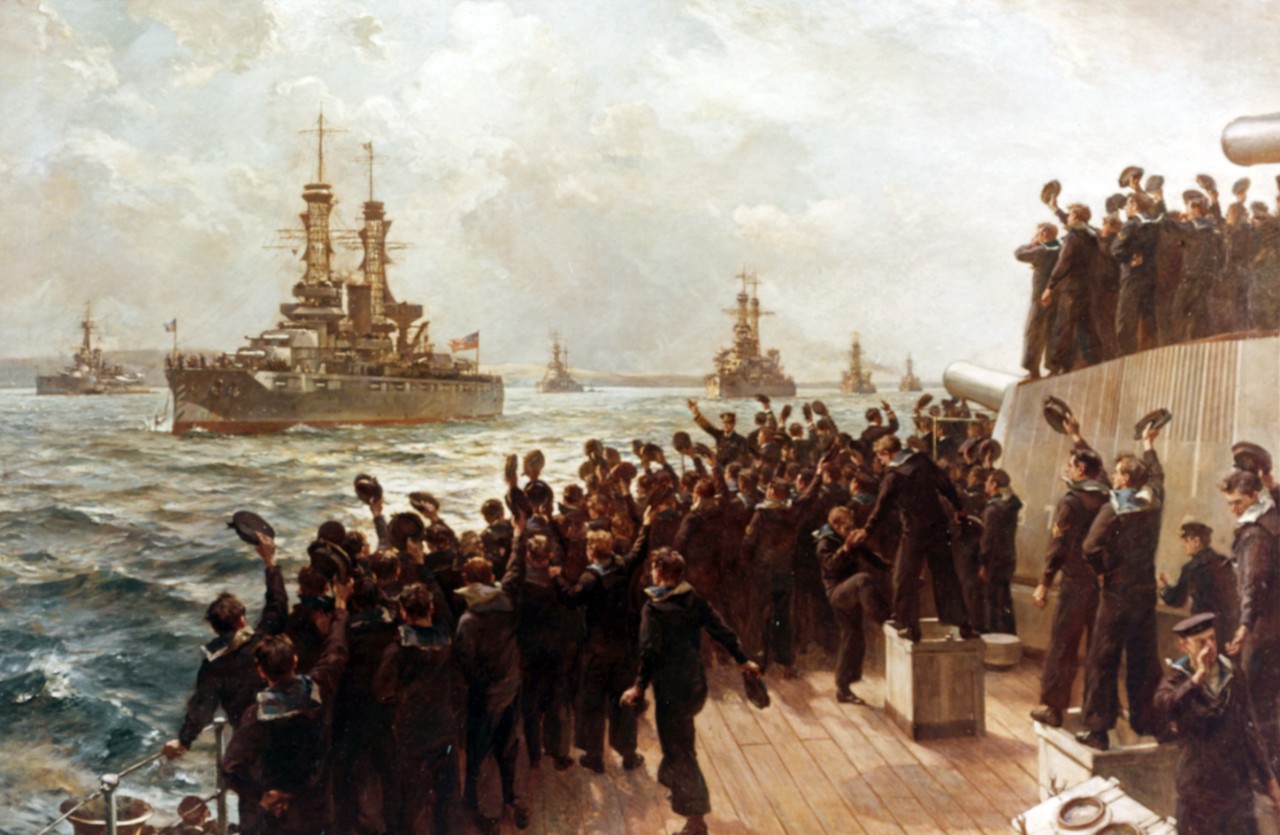
The U.S. battleships continued to serve together and Battleship Division Nine was re-designated as the Sixth Battle Squadron where it was to serve as a fast wing in the Grand Fleet. Upon arrival the Americans adopted British procedures regarding tactics and communications. On 17 December, Delaware, as part of the Sixth Battle Squadron, got underway in company with HMS Queen Elizabeth, Beatty’s flagship, and left Scapa Flow for the Firth of Forth, arriving the following day. While basing on the Firth, the opportunity was taken to exercise in British maneuvers and become accustomed to British signaling. Liberty parties were also sent to Edinburgh, Scotland, over the Christmas holidays.
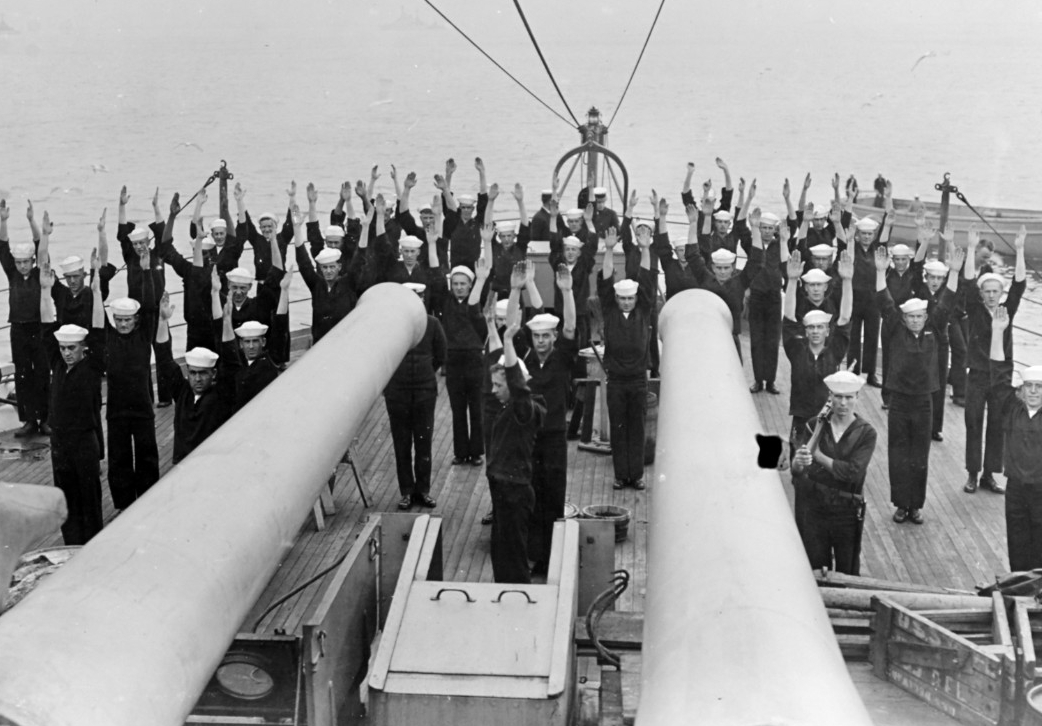
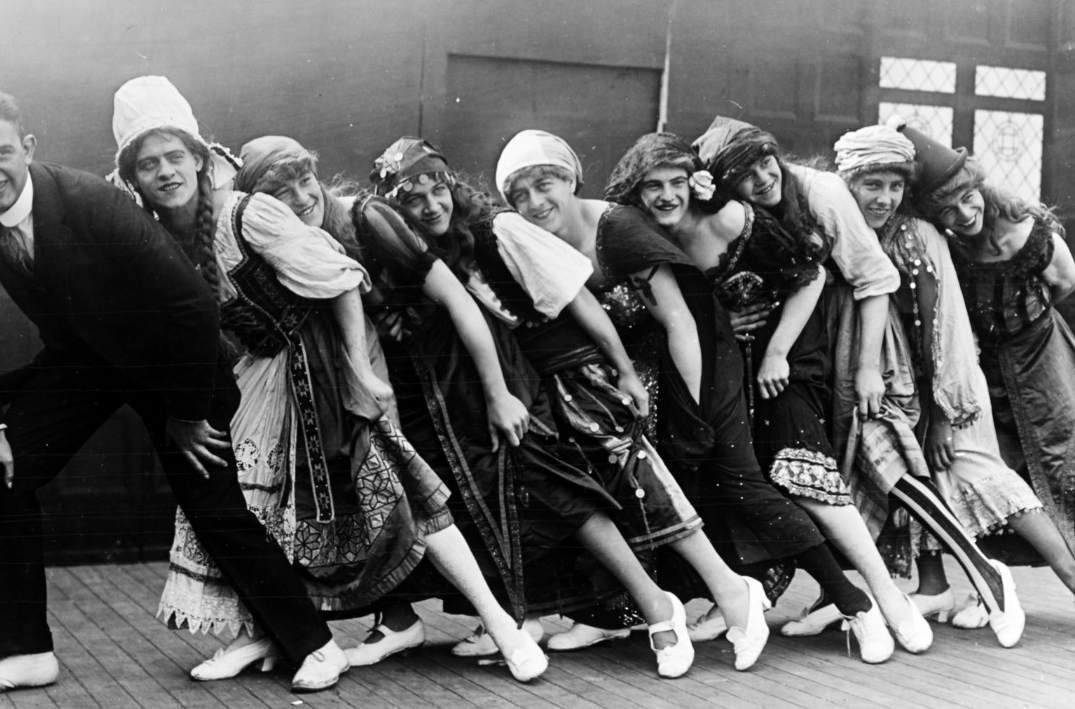
On 14 January 1918, the Sixth Battle Squadron left the Firth for Scapa Flow, in company with Queen Elizabeth and HMS Iron Duke, arriving the following morning. The battle squadron fired a target practice in Pentland Firth on 24 January. Texas (Battleship No. 35), on 30 January, sailed from New York to join the Sixth Battle Squadron at Scapa Flow. The next day, 31 January, the Grand Fleet, including the Sixth Battle Squadron, went to sea and performed tactical exercises and battle problems, returning to Scapa Flow on 2 February. The Sixth Battle Squadron, accompanied by eight British destroyers, left Scapa Flow with orders to convoy merchantmen to Norway on 6 February. The convoy was sighted at daylight on 7 February and the Sixth Battle Squadron took its position to the southeast as an escort.
On 8 February, at 1:17 p.m., while cruising off Stavanger, Norway, the Sixth Battle Squadron was subjected to a concerted attack by German U-boats. At 1:22 p.m., New York made a signal indicating a submarine sighting to starboard. This was followed by a signal from Wyoming that a submarine was in sight, bearing 30°. Shortly afterward Florida (Battleship No. 30) turned 180° while making the submarine signal and stating that a torpedo wake had crossed her bow from starboard to port. Accompanying destroyers dropped depth charges in the vicinity of Florida’s wake. New York, the flagship, made several signals for changes of course and Delaware immediately prepared for full speed.
At 1:53 p.m., the officer in Delaware’s spotting top reported a torpedo three points on the starboard bow crossing the ship’s track. The con put the rudder hard right and the torpedo crossed several hundred yards ahead of the ship. As the ship swung rapidly to starboard the wake of a torpedo or periscope was reported from the same general direction. The con steadied the ship with the wake a little on the port quarter and Delaware making full speed. She fired one shot from the port 3-inch anti-aircraft gun which went 200 yards over at a range of 2,000 yards. About this time one of the destroyers screening Delaware dropped a depth charge.
At 2:08 p.m., a lookout aloft reported the wake of a torpedo dead ahead. The con put the rudder hard left and passed just inside of the wake which was not seen again after passing abaft the beam. Delaware the made speed for some minutes to clear the locality and then maneuvered to rejoin the squadron.
At 2:35 p.m., there was a sighting of suspicious objects floating in the water about 800 yards distant off the starboard beam. The accompanying destroyers were informed and investigated. The objects were reported to be fishermen’s floats. Early the next day, 9 February 1918, the convoy was sighted on and escorted to Britain. Delaware returned to Scapa Flow with the squadron on 10 February. Having skillfully evaded the torpedoes, Capt. Scales received a letter of commendation from Rear Adm. Rodman for the handling of the ship in the action off Stavanger. Texas arrived at Scapa Flow at 2:00 p.m. on 11 February, and became the fifth ship in the Sixth Battle Squadron. The Grand Fleet went to sea at 1:00 a.m. on 16 February, to reinforce the Fourth Battle Squadron, the Fleet returned to Scapa Flow the next day.
Delaware, as part of the Sixth Battle Squadron, escorted a convoy of merchantmen from 8-12 March 1918 and returned to Scapa Flow on the 13th. In company with the British destroyers HMS Watchman and HMS Sabrina, Delaware left Scapa Flow on 2 April, en route to Newcastle-on-Tyne, England, where they arrived early the next day. At 7:00 a.m. on 3 April, Delaware drydocked for repairs and the installation of paravane gear. On 16 April, accompanied by the destroyers HMS Verdun and HMS Onslaught, she left the Tyne River and anchored in the Firth of Forth on the morning of 17 April. The Sixth Battle Squadron, without Delaware, performed a convoy escort mission (17-20 April). The Grand Fleet, on 24 April, with Delaware as part of the Sixth Battle Squadron, sortied to reinforce the Second Battle Cruiser Squadron which was on convoy duty and being threatened by German Battle Cruisers. Contact with the Germans was made at 10:00 a.m. on 25 April, by vessels in the van, but no action followed. The Grand Fleet returned to its base at Rosyth on 26 April.
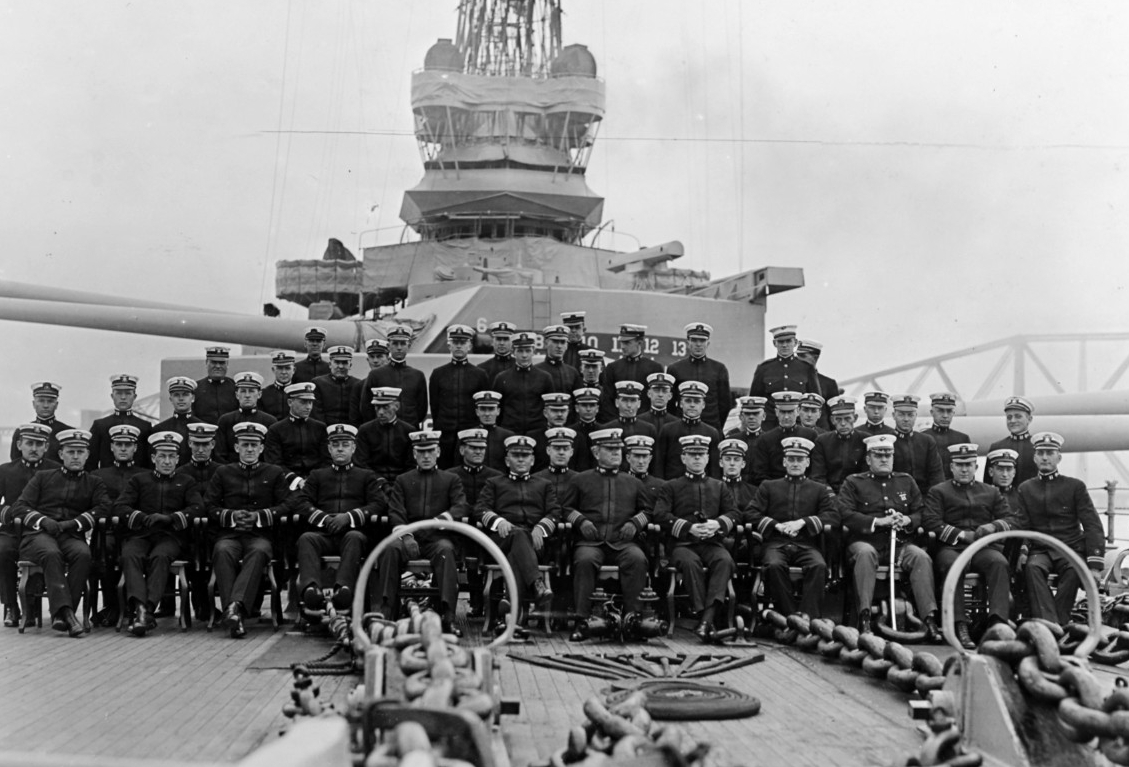
Delaware, along with the Grand Fleet, changed her base and steamed to Scapa Flow on 10 June, arriving the next day. While at Scapa Flow, she conducted various target practices for her main and secondary batteries. On 30 June, the Sixth Battle Squadron, with a division of British destroyers as an escort, went to sea to screen American ships laying the North Sea mine barrage. The ships returned to Scapa Flow on 2 July. Four days later, on 6 July, the Grand Fleet went to sea for tactical exercises and war problems and returned to its anchorage in the Firth of Forth at Rosyth on 8 July.
Arkansas (Battleship No. 33) left the United States to join the Sixth Battle Squadron and relieve Delaware on 14 July 1918. During this passage, King George V inspected the ships of the Grand Fleet at Rosyth on the 22nd. Arkansas arrived at Rosyth a week later on 29 July. Effectively relieved, Delaware, stood out of Rosyth on 30 July. Accompanied by the British destroyers HMS Rowena and HMS Restless, she steamed for the Virginia capes and home. Delaware parted company with her escort on 1 August, and raised Hampton Roads on the 12th.
Delaware re-joined the Atlantic Fleet at the York River on 13 August 1918. After undergoing post-deployment repairs, she remained in Chesapeake Bay engaged in target practice maneuvers and exercises through the end of hostilities on 11 November. The next day, she got underway for Boston, Mass. Entering the Navy Yard on 14 November, she underwent overhaul into the first quarter of 1919.
Delaware, with her yard work completed, departed for annual winter exercises in Caribbean waters on 11 March 1919. With her arrival at Guantanamo Bay on 18 March, she re-joined the Atlantic Fleet and was assigned to the Fifth Battleship Division, Squadron Three. Returning to New York on 14 April, she would continue to operate in division, squadron and fleet maneuvers from 1920 through 1922.
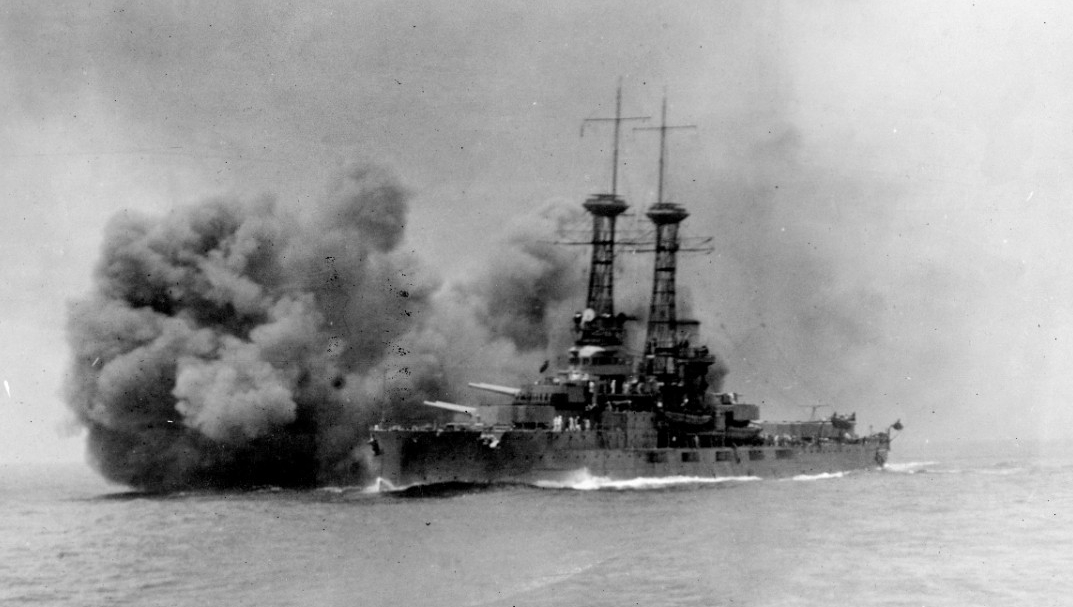
Delaware’s designation was changed to BB-28 as part of a Navy-wide administrative change on 17 July 1920. She participated in the Presidential Fleet Review at Hampton Roads on 28 April 1921. She later made two midshipmen practice cruises, one to Colon, C.Z.; Martinique; and other ports in the Caribbean, and the other to Halifax, N.S., Canada, between 5 June and 31 August 1922. Her homeport changed to Boston on 1 May 1923 and Delaware was assigned to duty with Battleship Division Two, Scouting Fleet. She then made a third midshipmen practice cruise, this time to Europe, visiting Copenhagen, Denmark; Greenock, Scotland; Cadiz, Spain; and Gibraltar between 9 July and 29 August 1923.
Delaware entered the Norfolk Navy Yard on 30 August 1923, and her crew was transferred to the newly-commissioned Colorado (BB-45), Delaware’s replacement in the Fleet. Moving to Boston Navy Yard in September, she was decommissioned on 10 November and rendered incapable of any warlike service on 19 November. Delaware was stricken from the Navy list on 27 November 1923 and sold on 5 February 1924, for scrapping in accordance with the Washington Treaty on the Limitation of Armaments.
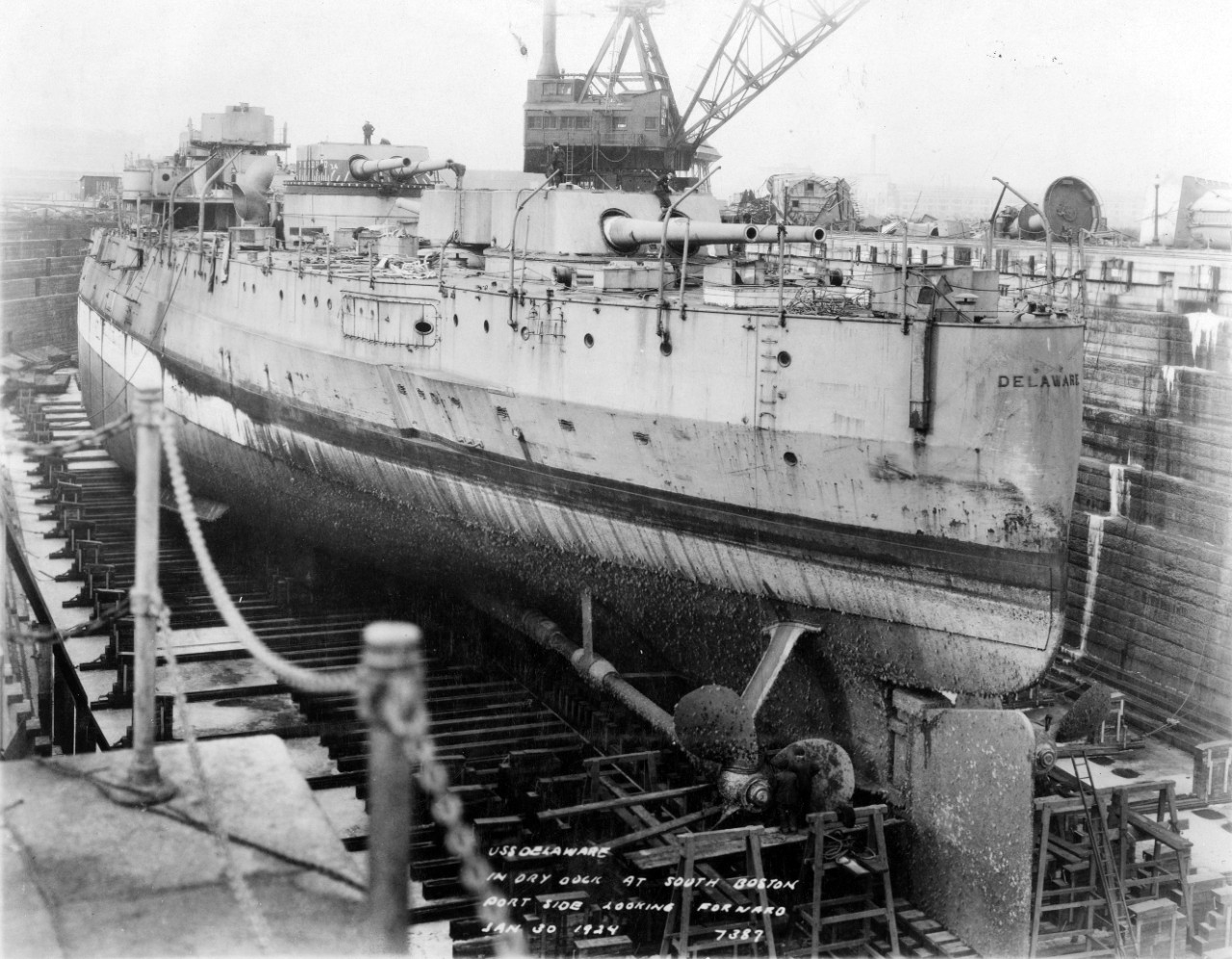
| Commanding Officers | Dates of Command |
| Capt. Charles A. Gove | 4 April 1910 – 20 November 1911 |
| Capt. John Hood | 20 November 1911 – 24 October 1912 |
| Capt. Hugh Rodman | 24 October 1912 – 22 December 1913 |
| Capt. William L. Rodgers | 22 December 1913 – 15 June 1915 |
| Capt. William A. Gill | 15 June 1915 – 27 May 1916 |
| Capt. Archibald H. Scales | 27 May 1916 – 29 November 1918 |
| Cmdr. John S. Abbott | 29 November 1918 – 14 December 1918 |
| Capt. Charles F. Preston | 14 December 1918 – 21 July 1919 |
| Capt. Reginald R. Belknap | 21 July 1919 – 23 May 1920 |
| Capt. John T. Tompkins | 23 May 1920 – 31 December 1921 |
| Capt. Robert W. Mc Neely | 31 December 1921 – 11 September 1923 |
| Cmdr. Vaughn K. Coman | 11 September 1911 – 10 November 1923 |
Christopher B. Havern Sr.
5 April 2017


